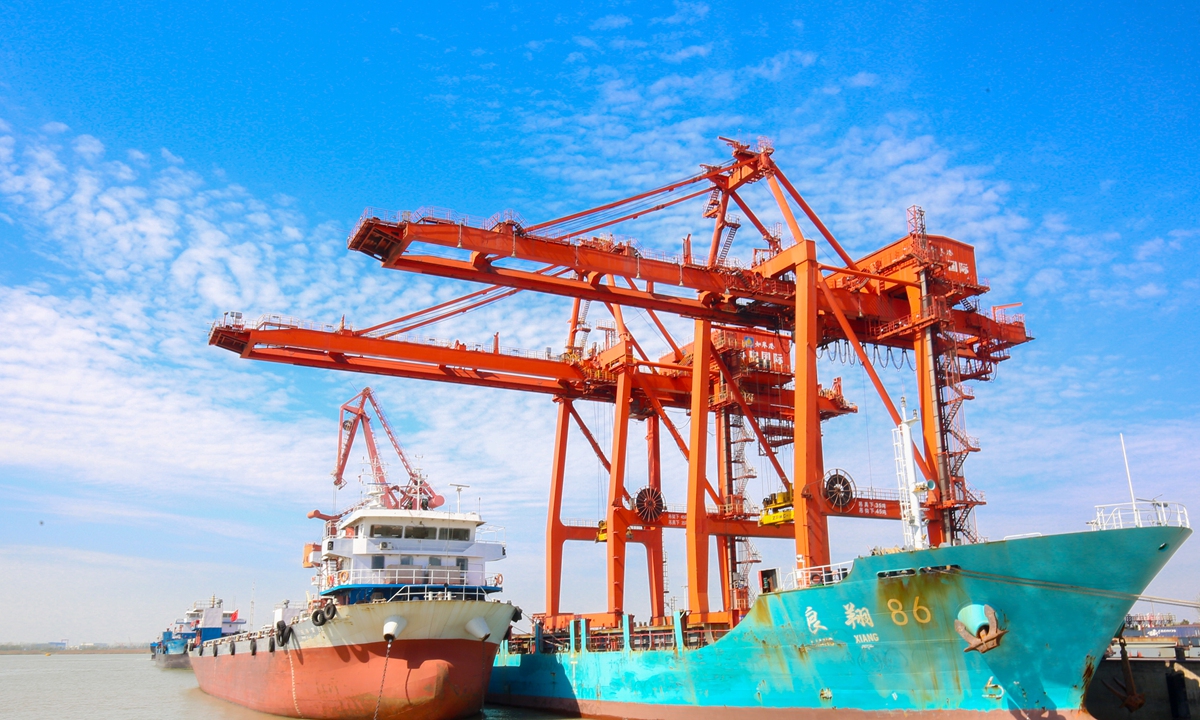
A cargo ship unloads goods at a port in Nantong, East China's Jiangsu Province on Monday. In the first quarter, container throughout at the port grew 51.9 percent year-on-year to 115,500 standard containers, and foreign trade container throughout soared 136.1 percent. Photo: CNSphoto
Chinese officials on Tuesday reported a 27.1 percent year-on-year growth for exports and imports in the first half of 2021 following 13 consecutive months of growth, shrugging off mounting pressure from a set of challenges, including surging raw material prices, resurgence of COVID-19 in China's major export hubs and other external hurdles.
Given the challenges and a complex environment, the trade figures further underscored the resilience of the world's biggest trading nation, analysts noted. However, more challenges and uncertainties could arise in the second half of the year, when growth might slow down, officials and analysts warned.
In the first six months of the year, total exports and imports surged 27.1 percent year-on-year to reach 18.07 trillion yuan (about $2.79 trillion), with imports increasing 25.9 percent year-on-year and exports growing 22 percent year-on-year, according to data from the General Administration of Customs (GAC) on Tuesday.
"China's total export and import volume has maintained growth for 13 consecutive months and reached a historical best level during the same period," Li Kuiwen, an official at the GAC, told a press briefing.
During the period, China also recorded high-speed growth with all major trading partners. Trade with the US rose 34.6 percent year-on-year, with ASEAN 27.8 percent and the EU 26.7 percent. In particular, despite trade tensions, China's exports to the US grew 31.7 percent, while imports from the US jumped 43.9 percent. Imports of US agriculture products surged 120.8 percent.
"Such a result is hard to come by, considering all the pressures we faced - rising costs, the pandemic as well as shifting global trade and economic recoveries," Bai Ming, deputy director of the international market research institute at the Chinese Academy of International Trade and Economic Cooperation, told the Global Times on Tuesday.
In the past several months, skyrocketing prices of major raw materials, including iron ore and metals, exerted a huge pressure on Chinese factories, prompting a swift action from officials to stabilize prices. "The rise of international bulk commodity prices sporadically lifted up firms' production costs," Li said.
In the first half of the year, China's iron ore imports increased 2.6 percent, while corn imports jumped 31.85 percent. Crude oil imports dropped by 3 percent.
The resurgence of COVID-19 cases in late May in South China's Guangdong Province, a major manufacturing and export hub, had a great impact on production at factories and shipping.
The challenges and the results highlighted China's resilience as the biggest trading country, adding that many trading partners still rely heavily on Chinese exports and imports, both when they face serious COVID-19 outbreaks and when they embark on a recovery process, Bai said.
Underscoring that, China's exports and imports with India, which was engulfed in one of the worst outbreaks of the COVID-19, surged 62.7 percent in the first half in dollar terms, the faster growth in China's trade with other countries during the period, official data showed.
However, Bai also warned that "the real challenge" is in the second half of the year.
Li, the official at the GAC, also warned that growth pace in exports and imports might slow down in the second half of the year. "At the moment, the COVID-19 epidemic is still spreading in many places around the globe, the trend of the epidemic is complex and trade development still faces many uncertain and unstable factors," Li said.
Amid the gloomy outlook, Chinese officials have in recent days moved to support companies, particularly small- and medium-sized companies, as part of a broad effort to stabilize trade in the second half.
"For the full year, there is still hope that imports and exports will maintain a relatively faster growth," Li said.




